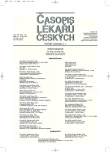Human genome sequencing – next generation technology or will the routine sequencing of human genome be possible?
Authors:
Š. Pospíšilová; B. Tichý; J. Mayer
Authors‘ workplace:
Fakultní nemocnice Brno a LF MU, Interní hematoonkologická klinika, Centrum molekulární biologie a genové terapie
Published in:
Čas. Lék. čes. 2009; 148: 296-302
Category:
Topic
Overview
DNA sequencing has become a standard method widely used in molecular genetic analysis of biological materials. Its use in medicine is widespread, especially in diagnostics of inherited disorders and cancer related diseases. Development of DNA diagnostics has been strongly accelerated by publication of the human genome sequence in 2001. During the last few years one can observe rapid development of novel sequencing technologies, which have led to the introduction of so called „New Generation Sequencing“. These new technologies based on principles of massive parallel sequencing (e.g. Roche/454, Illumina Genome Analyzer IIx, Life Technologies SOLiD 3 and others) enable a massive increase of sequencing capacity and in parallel also a fundamental decrease of costs. This major technological breakthrough allowed development of the whole-genome sequencing including analyses of individual human genomes. It also started the era of personal genomics. The first sequenced individual human genomes belonged to famous geneticists J. C. Venter (2007) and J. D. Watson (2008), but they were rapidly followed by sequencing analyses of other individuals from various ethnic groups. These studies brought substantial information about interpersonal differences in genome structure (through characterization of nucleotide polymorphisms, DNA deletions and amplifications etc.). Sequencing of cancer cell genomes, e.g. acute myeloid leukemia has already brought first important clinically relevant results. Although currently we are still unable to interpret the relevance of all detected genome variants, it is obvious, that the possibility to sequence individual human genomes represents a fundamental breakthrough not only in DNA diagnostics but also in clinical medicine.
Key words:
genome, DNA, sequencing, next-generation sequencing.
Sources
1. Moudrianakis EN, Beer M. A selective reagent for the study of base sequence in nucleic acids. Nature 1964; 204 : 685–686.
2. Sanger F, Nicklen S, Coulson AR. DNA sequencing with chain-terminating inhibitors. Proc Natl Acad Sci USA 1977; 74 : 5463–5467.
3. Sanger F, Air GM, Barrell BG, et al. Nucleotide sequence of bacteriophage phi X174 DNA. Nature 1977; 265 : 687–695.
4. Maxam AM, Gilbert W. A new method for sequencing DNA. Proc Natl Acad Sci USA 1977; 74 : 560–564.
5. Smith LM, Sanders JZ, Kaiser RJ, et al. Fluorescence detection in automated DNA sequence analysis. Nature 1986; 321 : 674–679.
6. Ansorge W, Sproat B, Stegemann J, et al. Automated DNA sequencing: ultrasensitive detection of fluorescent bands during electrophoresis. Nucleic Acids Res 1987; 15 : 4593–4602.
7. Bashkin JS, Bartosiewicz M, Roach D, et al. Implementation of a capillary array electrophoresis instrument. J Capillary Ellectrophoresis 1996; 3 : 61–68.
8. Fleischmann RD, Adams MD, White O, et al. Whole-genome random sequencing and assembly of Haemophilus influenzae Rd. Science 1995; 269 : 496–512.
9. Adams MD, Celniker SE, Holt RA, et al. The genome sequence of Drosophila melanogaster. Science 2000; 287 : 2185–2195.
10. Weber JL, Myers EW. Human whole-genome shotgun sequencing. Genome Res 1997; 7 : 401–409.
11. Venter JC, Adams MD, Myers EW, et al. The sequence of the human genome. Science 2001; 291 : 1304–1351.
12. Lander ES, Linton LM, Birren B, et al. International Human Genome Sequencing Consortium: Initial sequencing and analysis of the human genome. Nature 2001; 409 : 860–921.
13. The ENCODE Project Consortium: Identification and analysis of functional elements in 1% of the human genome by the ENCODE pilot project. Nature 2007; 447 : 799–816.
14. Levy S, Sutton G, Ng PC, et al. The diploid genome sequence of an individual human. PloS Biol 2007; 5 : 254–286.
15. Wheeler DA, Srinivasan M, Egholm M, et al. The complete genome of an individual by massively parallel DNA sequencing. Nature 2008; 452 : 872–877.
16. Kidd JM, Cooper GM, Donahue WF, et al. Mapping and sequencing of structural variation from eight human genomes. Nature 2008; 453 : 56–64.
17. Wang J, Wang W, Li R, et al. The diploid genome sequence of an Asian individual. Nature 2008; 456 : 60–65.
18. Ley TJ, Mardis ER, Ding L, et al. DNA sequencing of a cytogenetically normal acute myeloid leukaemia genome. Nature 2008; 456 7218 : 66–72.
19. Mardis ER. The impact of next-generation sequencing technology on genetics. Trends Genet 2008; 24 : 133–141.
20. Pettersson E, Lundeberg J, Ahmadian A. Generations of sequencing technologies. Genomics 2009; 93 : 105–111.
Labels
Addictology Allergology and clinical immunology Angiology Audiology Clinical biochemistry Dermatology & STDs Paediatric gastroenterology Paediatric surgery Paediatric cardiology Paediatric neurology Paediatric ENT Paediatric psychiatry Paediatric rheumatology Diabetology Pharmacy Vascular surgery Pain management Dental HygienistArticle was published in
Journal of Czech Physicians

Most read in this issue
- Bilateral spontaneous pneumothorax – wrong therapies
- Human genome sequencing – next generation technology or will the routine sequencing of human genome be possible?
- Eosinophils in the gastrointestinal tract
- On human ageing and longevity – 2. internal determinants
